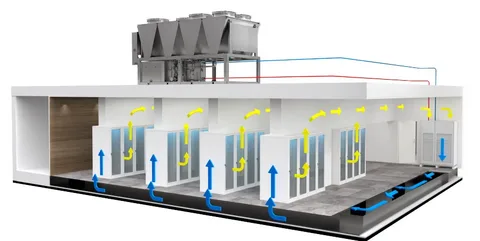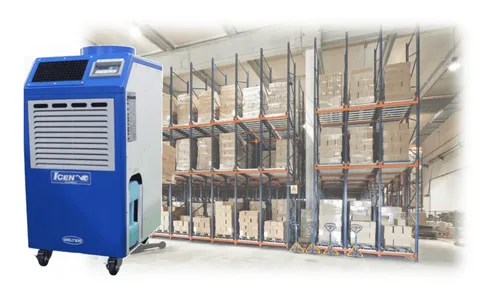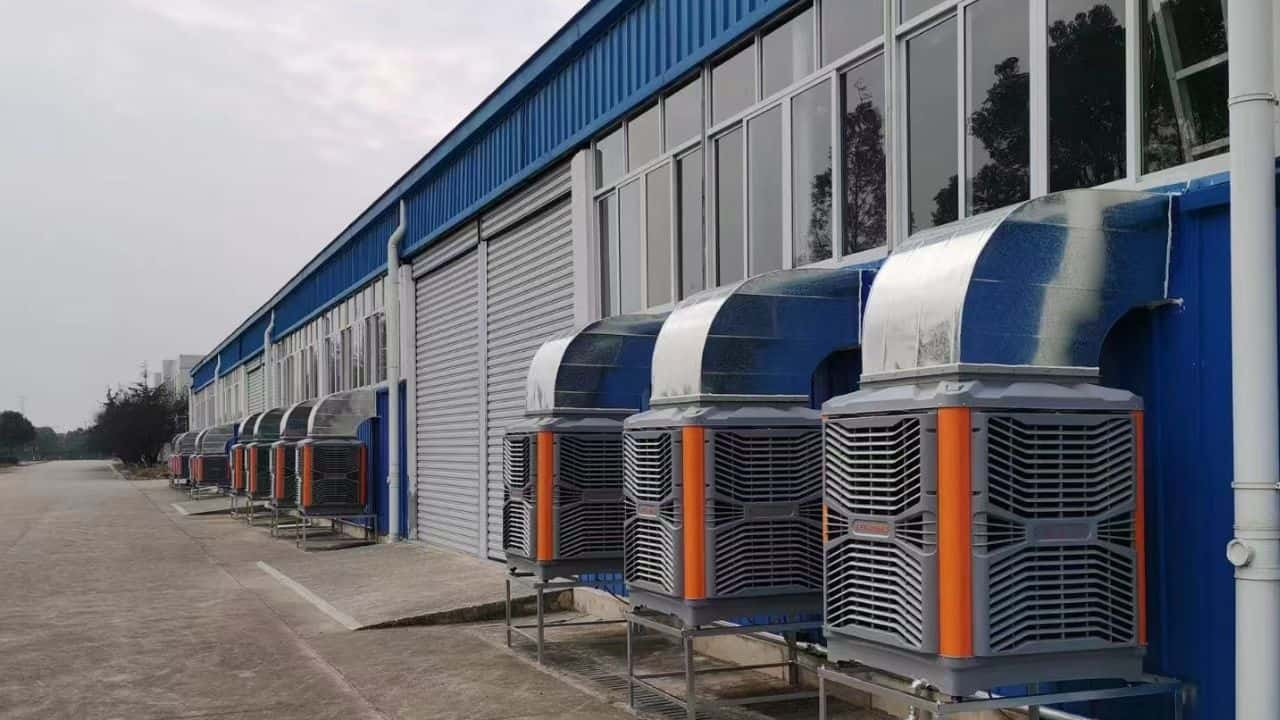Introduction: Why Sustainability Matters in Logistics
Sustainability is a new policy in the contemporary logistics, influenced by the corporate ESG (Environmental, Social, Governance), regulatory requirements, and customer desire to see greener supply chains. The fact that logistics centers are energy guzzlers is also being questioned to diminish their carbon footprint. Although effective, traditional HVAC systems use a lot of energy and use refrigerants that damage the environment, which are not ideal in the green warehouse cooling objectives.

A better option is eco-friendly cooling logistics with evaporative air systems that will reduce energy consumption by up to 80 percent and remove the harmful refrigerants. This paper discusses the role of evaporative coolers in meeting sustainability goals, which provide cost reductions, enhanced employee comfort, and enhanced brand image of logistics operators.
The Role of Sustainability Goals in Warehousing and Distribution
According to the data provided by the U.S. Department of Energy (DOE), logistics and warehousing are some of the most energy-intensive industries, with a cooling system taking up 25 – 30 per cent of the energy consumption. The pressure on companies to be sustainable has been increasing because of:

- Corporate ESG Promises: Investors and stakeholders want to see tangible results on Net Zero and carbon cutting targets.
- Regulatory Requirements: Policies such as EU Green Deal and U.S. DOE energy programs drive towards the reduction of emissions.
- Client Expectations: Online stores and e-commerce giants are interested in cooperating with environmentally friendly logistic service providers.
Sustainable evaporative cooling is the solution to these requirements because it minimizes the use of energy and is suitable to the requirements of global sustainability standards, including LEED and ISO 14001 certifications.
Evaporative Coolers vs. HVAC Systems: Carbon Footprint Comparison
The greenness of cooling systems is a key concern to the logistics centres that want to lower their carbon footprint.
Traditional HVAC Systems:
- High Energy Demand: Compressors and fans require 3-6 KW/hour of a 50,000-square-foot warehouse, which is 20,000-40,000/year at 0.15/kWh.
- Refrigerant Emissions: According to IPCC climate reports, HFCs are thousands of times stronger than CO 2 in global warming.
- Carbon Footprint: An average HVAC system has a yearly carbon dioxide mass of 100150 tons of CO 2 equivalent.

Evaporative Coolers:
- Low Energy Use: Use 0.51 kW/hour, which saves 70-80% of energy, which costs ASHRAE standards at only $5,000-10,000/year.
- None Refrigerants: Only water and fans are used, which exclude the emission of HFC.
- Carbon Savings: According to DOE energy models, by replacing a 50,000-square-foot warehouse with evaporative cooling, it is possible to reduce emissions by 80120 tons of CO 2 per year.
This will form the basis of evaporative coolers in the warehouse cooling of carbon footprint.
Cooling and ESG Reporting for Logistics Companies

Evaporative cooling contributes to ESG directly:
- Environmental (E): Saves up to 80% of energy, reducing greenhouse gas emissions, and helps to meet Net Zero targets. Savings through energy meters can be tracked to release ESG reports at the facilities.
- Social (S): Enhances the comfort of the workers in fresh, high oxygenated air reducing heat stress and increasing productivity by as much as 15 percent according to occupational health research.
- Governance (G): Congruent with the sustainability certifications (e.g., LEED, ISO 14001), which show the adherence to the environmental regulations and corporate policies.
Evaporative cooling can be included in ESG reports by logistics companies to demonstrate quantifiable improvements, i.e. 30% cut in the amount of cooling-related emissions, to increase the visibility with stakeholders.
Brand Value: How Green Cooling Enhances Reputation
The implementation of ESG logistics cooling solutions such as evaporative coolers reinforces brand positioning:
- Retaining Clients: The new partners will receive new contract options because eco-friendly retailers and online retail giants are attracted to partners with the green certificate.
- Stakeholder Trust: Illustrating the commitments of sustainability generates investor and local trust.
- Market Differentiation: Marketing of the green warehouses will make companies stand out of the crowded industry.
Case Example: A logistics company in Spain that uses evaporative coolers in its 100,000-foot facility reduced its emission by 120 tons every year. Through advertising its green warehouse cooling system, the corporation won one of the biggest agreements with a sustainability-oriented retailer, which increased its revenue by 10 percent.
Broader Benefits of Sustainable Cooling Solutions

In addition to reducing carbon, evaporative coolers also have other benefits:
- Cost Savings: Annual operating expenses are 7080 percent less than HVAC, which will save a mid-sized facility 15, 000 to 30, 000 each year.
- Better Air Quality: There is always fresh air circulating that eliminates stuffiness and odors as opposed to recycles of air by HVAC, which is good in preventing illnesses to workers.
- Regulatory Compliance: Consonant with the world sustainability policies, e.g., EU Green Deal and U.S. DOE energy efficiency programs.
- Net Zero Contribution: A long-term acceleration of decarbonization, making logistics centers the basis of sustainable supply chains.
The mentioned advantages make sustainable evaporative cooling a long-term investment to consider by visionary operators.
Key Takeaways for Facility Managers
To introduce eco-friendly logistics cooling, the logistics managers should:
- Evaluate Climate: Evaporative coolers perform well in dry climates (e.g. Southwest U.S, Middle East) but might necessitate hybrid HVAC systems in more humid areas.
- Select CFM According to the Size of the Facility: Select CFM according to the size of the facility (e.g. 20,00030,000 CFM to a 50,000 square-foot warehouse).
- Measure Carbon Saving: Actualize energy meters and ESG software to measure emissions reductions to report.
- Green Upgrades: It is important to emphasize on cooling efficiency in marketing and sustainability reports to appeal to clients with green concerns..
Pro Tip: Collaborate with cooling specialists such as KoolAir to develop systems that are highly energy efficient and compatible with the ESG requirements.
Conclusion: Green Cooling for the Future of Logistics
Evaporation air vapor warehouse cooling is changing all the logistics centers, offering un-costly energy consuming industrial cooling that lowers expenditures, carbon effects and adds worth to the brands. Evap coolers make logistics operators the sustainability leaders by cutting down on energy consumption up to 80 percent, removing toxicate refrigerants, and endorsing the ESG goals. These systems will be a strategic future of logistics, whether it is to achieve cost savings, comfort of the workers, or global compliance.
Are you willing to fit your operations into the sustainability objectives? See the possibilities of ESG logistics cooling with KoolAir solutions to cut down on emissions, cut on expenses and improve on your green supply chain image.
